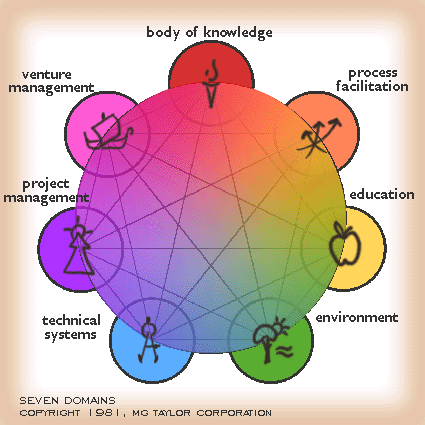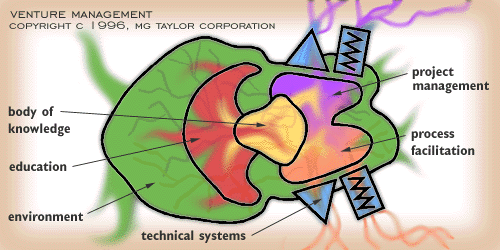
|
|
Like the other models of the MG Taylor Modeling Language, the 7 Domains® Model is protected by copyright. You can use it only by meeting these four conditions. Here's the basic representation of the model:
Let's continue with a brief look at each of the domains:
7 Domains and Vantage PointsIt's often useful to create a matrix out of several of the models together. The 7 Domains goes nicely with the Vantage Points model and the Creative Process model (not yet online). You'll notice in the above definitions the frequent use of the words philosophy, culture and methods. Philosophy and Culture are the two broadest levels of vantage points. Methods refers to the Policy, Strategy, Tactics, Logistics and Task levels of the model. Here's an example using Project Management. An enterprise will have a philosophy about project management, which will likely be hidden from consciousness but is expressed clearly in its culture. There will be policies concerning how projects are to be pursued (maybe written, maybe experientially embedded in oral tradition); who can initiate them, the rituals by which funding and approval is secured, how updates are transmitted and to whom, and so on. Managers will develop a stock of strategies to use in seeking approval for projects and to guide the planning and implementation process. Next come tactics which might be expressed in the choice of project management software or other tools. Training programs fall under this vantage point as well. Logistics concerns procedures for procuring and managing specific resources during the course of the project. Finally come the thousands of tasks that must be learned to run the entire system from Philosophy through Logistics. The Domains are a SystemMost of us tend to examine the domains serially, out of our reductionist habits. We talk about them one at a time and one after the other. When we do a 7 Domains® Audit, we examine each domain in turn. There's nothing wrong with this approach; it is, however, a woefully incomplete approach. The domains are connected to one another in weblike fashion. It's much more interesting and valuable, therefore to think about things like the Environment of Process Facilitation, or the Environment of Technical Systems, or the Technical Systems of the Body of Knowledge, or the Venture Management of Education. If you wish to be systematic about it, then consider each of the domains in the context of the others, as in the examples from the previous sentence. Why Seven? Why These Domains? Where are the People?A frequently asked question about the domains concerns why human resources or team spirit or some other people-oriented domain seems to be missing. To answer that, first understand that the title "7 Domains" is incomplete and should be completed based on how it is to be used. In the 1980's its most common full title was "The Seven Domains of Corporate Health." I have used the title "The 7 Domains of Collaborative Design" when using the model with respect to creating Management Centers. Even these two titles are not complete. The word "Managing" must be prefixed to each, thus, "Managing the 7 Domains of Collaborative Design." This brings us to a fundamental philosophical tenet of MG Taylor Corporation. People are not resources to be managed. Instead, people collaboratively manage the 7 Domains to achieve together what they cannot achieve separately. Once people focus on managing each other, a false sense of control is substituted for the powerful properties of collaboration. When we look for machine-like predictability from people, we deny and sacrifice the organic, dynamic qualities that enable synergy and true homeostasis to emerge. Therefore, the 7 Domains do not include people as "resources", nor are they focused on the management of people. As to why seven, there's no particular reason, however, the domains do form a whole picture... A Venture is composed of projects and processes. These two overlap--there's no clear definition that divides projects from processes. Both must be managed and facilitated to maintain balance and growth. The Venture lives within and creates its environment or environments--the field on which the game is played. It calls upon a body of knowledge to execute its projects and processes. It employs technical systems that enable its metabolism to remain requisite with its surroundings--managing lags, avoiding collisions, employing hunting strategies as guidance mechanisms for staying on specification, compensating for unwanted changes in energy thruput or system velocity. Finally, it engages an education system to manage learning--a discovery and feedback system whose purpose is to add to, analyze, and winnow the body of knowledge.
copyright © 1996, MG Taylor Corporation.
All rights reserved 19961104125637.web.bsc |
|
Copyright,
|
iteration
3.5
|




















